It's autumn, which means that new 2013 cars are now showing up in dealerships all across the country.
With gas prices high and new fuel-economy standards in effect, automakers are rolling out new green cars of every type.
Here's our selective list of the important new green models you'll be able to buy over the next year.
Not surprisingly, the bulk of them are hybrids, including a few from makers you may not know offer them--Acura, BMW, and Volkswagen, for instance--and a few more from hybrid powerhouse Toyota.
There aren't too many new diesels this year; the 2014 model year will change that, with two significant new entries coming.
And there are a few new electric cars coming too, though two of the three are low-volume "compliance cars" that won't be sold nationwide.
Finally, it's important to keep in mind that gas mileage is going up on all classes of vehicles, prompted by new fuel-efficiency standards adopted by the EPA and NHTSA in 2009.
So before you conclude that a hybrid is your only option for high gas mileage, check out the conventional gasoline models.
While they won't match the mileage of hybrids for the same size of car, you may be pleasantly surprised that the 25-mpg compact sedan of several years ago is now a 33-mpg car.
NEW HYBRIDS and PLUG-IN HYBRIDS
A number of new hybrid models are being launched for 2013, including the first direct competitor to the iconic Toyota Prius.
Four of the new models come from Ford, which sold the first U.S.-built hybrid way back in 2004. All four use the latest generation of its hybrid drive system, and two of the four plug in as well.
The 2013 Acura ILX is a new entry and the smallest model from Honda's luxury sports brand.
The four-door sedan is essentially a Honda Civic underneath, and all three versions are assembled in the U.S.--including the ILX Hybrid, which has the least powerful of the three engines offered in the ILX sport sedan.

2013 Acura ILX Hybrid, New York City, July 2012
The ILX Hybrid uses the same 1.5-liter four-cylinder engine and integrated 15-kilowatt (23-hp) electric motor as the 2012 Honda Civic Hybrid. The motor is powered by a small lithium-ion battery pack in the trunk; the powertrain's combined output is 111 hp and 127 pound-feet of torque.
Our reviewer noted that, at times, the 2,900-pound ILX Hybrid "feels very, very sluggish, particularly with the ECON mode enabled, which widens the idle-stop window, retards the throttle response, and minimizes climate control loads."
The Acura ILX Hybrid is the brand's first hybrid to be built in the U.S. It follows last year's Honda Civic Hybrid, which was the first hybrid Honda has ever built in the States.
Those two cars are likely not to be the last hybrid offerings sold in the largest global market for Honda hybrids, however.
2013 BMW ActiveHybrid 3, 5, and 7

2013 BMW ActiveHybrid 3
Over 18 months, BMW is updating its 2013 ActiveHybrid 7 full-size luxury sedan with a new powertrain.
It's also introducing two new hybrid sport sedans--the the 2012 BMW ActiveHybrid 5 mid-size and the 2013 BMW ActiveHybrid 3 compact --that use the same powertrain as well.
All three sedans use a 300-hp turbocharged straight-six, with a 40-kW (55-hp) electric motor sandwiched between the engine and an eight-speed automatic transmission modified to work even if the engine is off.
Total power output is 335 hp and 330 pound-feet of torque.
While they're more economical than engines of similar output without the hybrid system, BMW isn't using its single-motor hybrid system to produce the highest fuel efficiency.
(That role falls to its diesel models, including a 3-Series diesel that may be launched during 2013 to join its diesel X5 crossover utility.)
But the hybrids will be offered globally, and they promise more electric running up to 45 mph--BMW claims up to 2.5 miles solely on electric power--than the old ActiveHybrid 7, whose mild-hybrid system just assisted its twin-turbo V-8 engine and couldn't move the car on its own.
Top speed of the hybrid models is limited to 155 mph, and the ActiveHybrid 3 is quoted with a 0-to-62-mph acceleration time of just over 5 seconds.
BMW's main green-car focus isn't hybrids, but its upcoming range of plug-in cars, to be known as the BMW i series.
The first of that line, the all-electric BMW i3 subcompact hatchback, will be launched next fall for the 2014 model year.
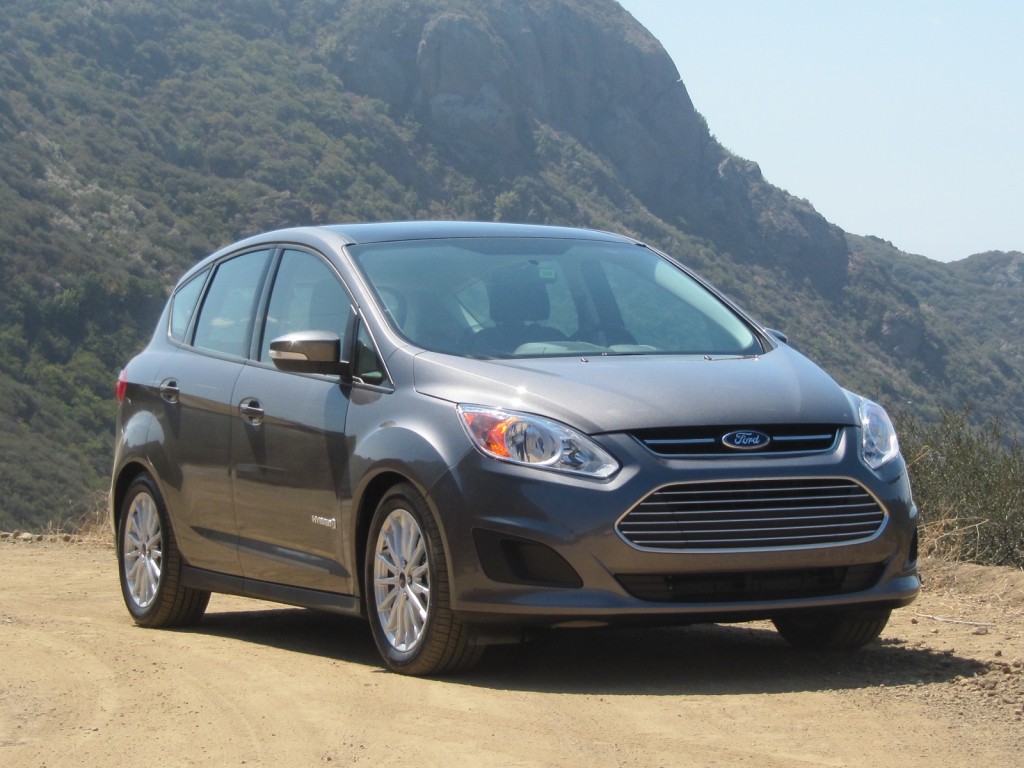
2013 Ford C-Max Hybrid, Los Angeles, August 2012
2013 Ford C-Max Hybrid and C-Max Energi
The most important new green model of the year may be the 2013 Ford C-Max Hybrid.
It's Ford's first-ever "dedicated hybrid," meaning it's a body style not shared with a conventional gasoline vehicle (at least in the U.S. market), and its 47-mpg EPA combined rating comes to within a few percent of the class-leading 50 mpg of the Toyota Prius.
And, frankly, in many ways the hybrid 2013 C-Max is a nicer and more pleasant vehicle to drive than the Prius.
Ford is pitching the C-Max against both the well-known Prius Liftback and the new-for-2012 Prius V wagon model.
The 141-horsepower, 2.0-liter four-cylinder engine and electric drive motor put out a combined maximum of 188 hp, which is 54 hp more than the powertrain in either Prius model.
The C-Max has more room for people and luggage than the hatchback Prius, but better performance and higher gas mileage than the somewhat underpowered Prius V.
And Ford has priced it reasonably: The base price is $25,995 (including delivery). That's $1,200 higher than the most basic Prius Liftback, but $1,300 lower than the lowest-line Prius V wagon.
There will also be a C-Max Energi plug-in hybrid model to be launched early next year. It's the same car, but with a larger battery pack that can be plugged into the wall to recharge.
That will give the plug-in C-Max an electric range up to 20 miles, and the five-person seating and cargo space that the Chevrolet Volt range-extended electric car--with its 38-mile electric range--can't match.
The C-Max is one of two pairs of hybrids that promise to put Ford back into the hybrid game, and offer fresh competition for the four-member Toyota Prius hybrid family.
2013 Ford Fusion Hybrid and Fusion Energi

2013 Ford Fusion Hybrid, New York City
The second pair of Ford hybrids to launch for 2013 are versions of its all-new and very stylish Fusion four-door sedan.
The previous Fusion Hybrid, sold from 2010 through 2012, handily beat its hybrid sedan competitors--the Camry Hybrid and Altima Hybrid--in EPA gas-mileage ratings.
Now, the 2013 Ford Fusion Hybrid looks set to do the same.
Like the C-Max Hybrid, it's rated at 47 mpg--and that rating applies to city, highway, and combined cycles, meaning it should deliver consistent efficiency regardless of how you use it.
The Fusion Hybrid uses an identical powertrain to the C-Max, a 141-horsepower, 2.0-liter four-cylinder engine paired to an electric drive motor for a maximum combined power of 188 hp.
And both new Ford hybrids also use a lithium-ion battery pack in the trunk.
We briefly drove the new 2013 Fusion Hybrid, but our short New York City drive route didn't give us any useful data on real-world fuel efficiency. For that, we'll have to wait for a full test drive later on.
The hybrid Fusion, which hasn't yet reached dealers, will also gain a related model next year, when the Fusion Energi plug-in hybrid launches in the spring.
It too will offer up to 20 miles of all-electric range, and its most direct competitor is likely to be the 2014 Honda Accord Plug-In Hybrid (see below).
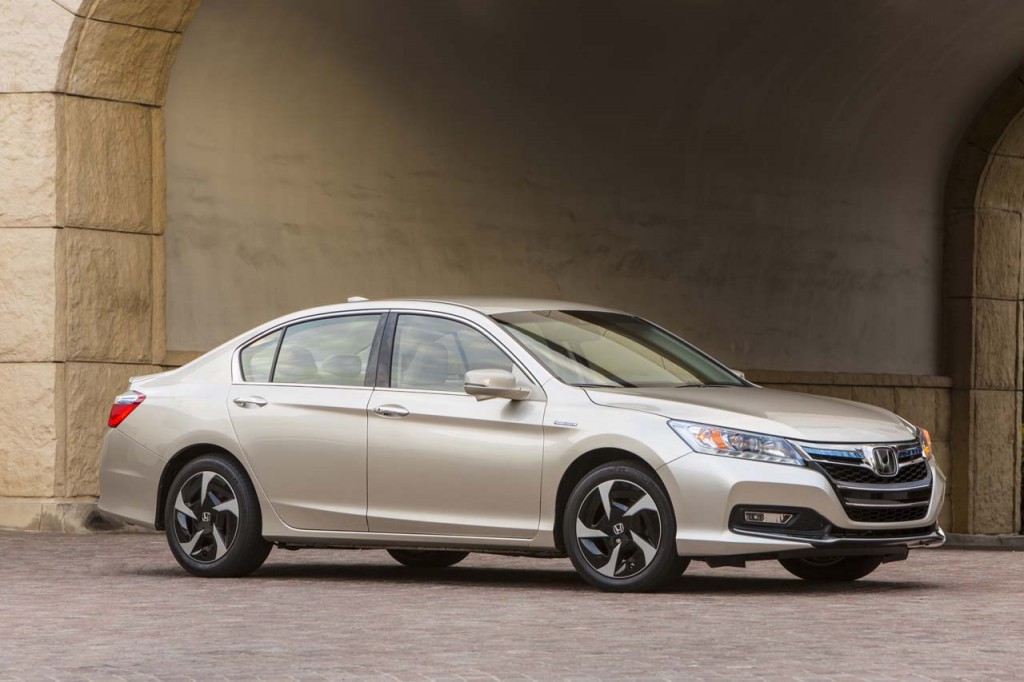
2014 Honda Accord Plug-In Hybrid
2014 Honda Accord Hybrid and Plug-In Hybrid
While they're technically 2014 models, the all-new Honda Accord mid-size sedan will offer its Plug-In Hybrid early next year and the conventional Hybrid model shortly thereafter.
So we've added them into this list because they're important new entries in the hybrid field.
Honda has been known for its mild-hybrid system, which since 1999 has used a small electric motor to supplement the gasoline engine and to act as a generator to recapture otherwise wasted energy by recharging a battery pack on engine overrun or braking.
The company concluded several years ago that for larger models--crossovers and mid-size sedans--it would need a larger, more powerful system with a pair of electric motors, similar to systems offered by Toyota and Ford.
The Accord Hybrid and Plug-In Hybrid are the first vehicles to use the system, but they certainly won't be the last.
We drove a prototype 2014 Honda Accord Plug-In Hybrid and found it smoother, more powerful, and more comfortable than the Toyota Prius Plug-In Hybrid.
The Accord Hybrid and Plug-In Hybrid will compete directly with the Ford Fusion Hybrid and Energi models, and by early spring, all four of them will be on the market.
Their conventional hybrid modes will also compete with the Toyota Camry Hybrid, the Hyundai Sonata Hybrid and Kia Optima Hybrid, and an upcoming new Nissan Altima Hybrid in 2014.

2013 Lexus ES 300h
Last year, Lexus quietly killed off its unsuccessful HS 250h model--the first hybrid car Toyota has ever withdrawn from the U.S. market.
No worries, Lexus lovers: There's a replacement for you, in the form of a hybrid model of the redesigned 2013 ES mid-size luxury sedan.
Like the Camry Hybrid on which it's based, the hybrid ES uses a 2.5-liter four-cylinder engine--tuned to run on the more efficient Atkinson Cycle--paired with the Toyota Hybrid Synergy Drive system.
The result is a combined 40-mpg rating from the EPA, which is both better than the HS achieved (at 35 mpg combined) and close to the Camry Hybrid rating, despite being heavier, more luxurious, and considerably more luxurious.
As with the related Toyota Avalon Hybrid, however, we suspect that a future Lincoln MKZ Hybrid model (based on the all-new 2013 Fusion Hybrid) will poses some serious competition to the ES 300h.
But now, at least, Lexus has a hybrid offering in the relatively high-volume mid-size near-luxury class--and it's not the unloved HS, which was oddly proportioned, slow, and remarkably noisy under full power.
Our first drive indicated that the new 2013 ES 300h "moves confidently and smoothly," and outdoes the outgoing HS with "better interior space, superior refinement, and even better mileage."
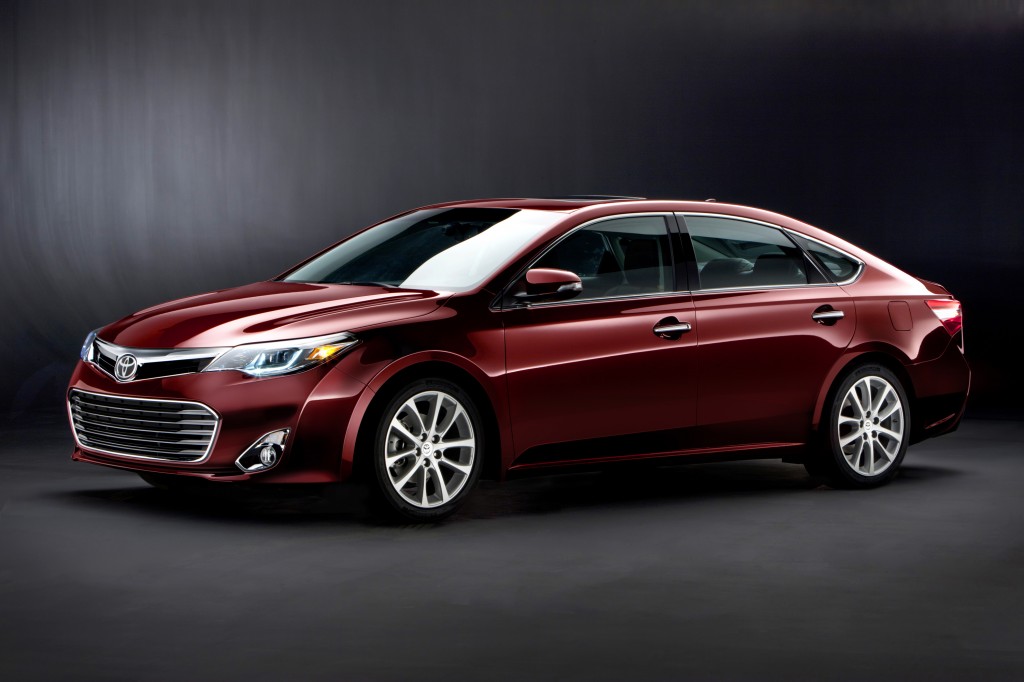
2013 Toyota Avalon
The redesigned 2013 Toyota Avalon full-size sedan is often viewed as a sort of Buick for Toyota buyers.
With marginally edgier styling and a fastback profile for 2013, the new Avalon also offers a new powertrain option: the first hybrid ever made available in Toyota's largest, plushest, cushiest sedan.
It's essentially the engine and Hybrid Synergy Drive system from the redesigned Camry Hybrid, a 2.5-liter four-cylinder engine paired with Toyota's two-motor-generator system.
And in the large, feature-laden Toyota Avalon, it returns a creditable 40-mpg combined EPA rating.
For comparison, that's far better than the combined 29 mpg for the Buick Lacrosse with eAssist, the mild-hybrid four-cylinder version of Buick's largest sedan, which is a direct competitor for the big, comfortable Toyota.
But just as the 2013 Ford Fusion Hybrid handily trounces the Camry Hybrid's fuel-economy rating, there may be a world of hurt in store for the hybrid Avalon.
There will undoubtedly be a hybrid version of the new 2013 Lincoln MKZ, probably as a 2014 model.
Since the outgoing 2012 MKZ Hybrid was already rated at 39 mpg--and the Fusion Hybrid that will spawn the new MKZ Hybrid comes in at 47 mpg--we expect the Avalon Hybrid to lose its big-car efficiency crown next year.
Meanwhile, Toyota continues toward its goal of a hybrid offering for every vehicle in its complete model line--which it says it will have done by 2015.

VW's Jetta Hybrid's Detroit Show First Look
To be launched very late this year, the new Jetta Hybrid will be VW's first-ever mass-market hybrid model (its pricey Touareg Hybrid crossover sells in very small numbers).
With a promised gas-mileage rating of 45 mpg combined, Volkswagen is setting an ambitious target for the Jetta Hybrid--and displacing its Jetta TDI diesel as the fuel-efficiency star of the Jetta lineup.
The 2013 VW Jetta Hybrid will be its first U.S. model--but not the last--to use a new, efficient 150-hp, 1.4-liter four-cylinder engine.
In this case, it's mated to a 20-kW (27-hp) electric motor that feeds into Volkswagen's 7-speed DSG direct-shift automatic manual gearbox, with a combined power output of 170 hp. That should make the Jetta Hybrid sporty and fun to drive as well as efficient.
VW says it can do roughly 1 mile on electric power, with all-electric running available as high as 44 mph, and the 0-to-60-mph time is about 9 seconds.
The Jetta Hybrid was first unveiled at January's Detroit Auto Show, and it resembles a standard Jetta with some detail changes--including LED running lights, special wheels with low-rolling-resistance tires, and some additional aerodynamic aids.
It will be priced from $24,995--with the higher-specification SE models priced at $26,990--putting it directly in Prius territory--though how many people cross-shop a Prius with a VW Jetta is debatable.
Volkswagen will be holding its press event for the new model later this month, so we'll know more about the hybrid Jetta in a few weeks.
NEW DIESEL MODELS
Relatively few new diesels are coming onto the market for 2013, although we expect more to arrive next year as 2014 models (including the Jeep Grand Cherokee EcoDiesel crossover and the Chevrolet Cruze diesel four-door compact sedan).
But so far, for 2013, we've only identified one new diesel entry in the U.S. market.

2013 Volkswagen Beetle Convertible
2013 Volkswagen Beetle TDI Convertible
Yep, there's a new ragtop version of the Beetle, which was completely redesigned for last year.
And it's a unique model, though: the sole diesel convertible on sale this year.
VW has fitted the Beetle TDI Convertible with the same 140-hp, 2.0-liter four-cylinder turbodiesel that it uses in the Jetta TDI compact sedan, the Golf TDI compact hatchback, and the Passat TDI mid-size sedan.
Fuel efficiency ratings aren't yet out for the convertible Beetle TDI, but the last time a diesel Beetle was sold in the States (its last year was 2006), the EPA rated it at 34 mpg combined with a five-speed manual, and 33 mpg with the six-speed automatic.
And it's worth remembering that Jetta TDI diesels often exceed their EPA ratings, as do the other models in the VW diesel line.

2012 Tesla Model S Signature
NEW ELECTRIC CARS
While plug-in cars are still a tiny fraction of the overall market, their 2012 sales will likely be more than twice the 2011 total of 17,500.
More and more makers are launching at least one plug-in vehicle, though a number of them are solely "compliance cars" sold to meet California laws--and it's important to know which is which.
For the 2013 model year, the most significant car is the big all-electric Tesla Model S luxury sports sedan. All the rest are just compliance cars, more's the pity.
Somewhat to the surprise of the conservative automotive industry, Silicon Valley startup electric-car maker Tesla Motors [NSDQ:TSLA] has managed to get its Model S all-electric luxury sport sedan into production by the end of 2012--as the company said it would.
While volume production is lagging several weeks behind schedule, the company is now up to production rates of 100 a week.
And it says it has 13,000 reservations from depositors eager to take their place in the queue of eager Model S buyers.
The long queue contrasts with troubled startup Fisker Automotive, which has likely built only 3,000 or so of its Karma range-extended electric car, and sold only perhaps 2,000.
The early Model S production is exclusively the Signature Series limited edition model, with the largest 85-kWh lithium-ion battery pack and an EPA electric-range rating of 265 miles.
Reviews of the 2012 Tesla Model S electric car have been largely glowing, with paeans to its performance, quietness, styling, and the stunning 17-inch touchscreen display.

2012 Tesla Model S, brief test drive, New York City, July 2012
Critics have also noted the relatively plain interior, low level of electronic features and luxury options, and of course the potential for battery degradation over time.
Tesla is currently facing owner complaints over its mandatory $600 yearly maintenance plan--for a car that transmits its battery state to the carmaker every day, and otherwise has almost no moving parts or replaceable items beyond tires and wiper blades--but it may yet change its policies.
Still, the Model S is already a game-changer, just as the company's two-seat electric Roadster was in 2009.
If Tesla can get its production up to the promised level of 15,000 cars a year, without notable quality glitches--and handle inevitable updates or recalls expeditiously--then it may show the established carmakers that electric cars are a lot closer, and a lot nicer, than anyone thought.
Stay tuned.
2013 Chevrolet Spark EV
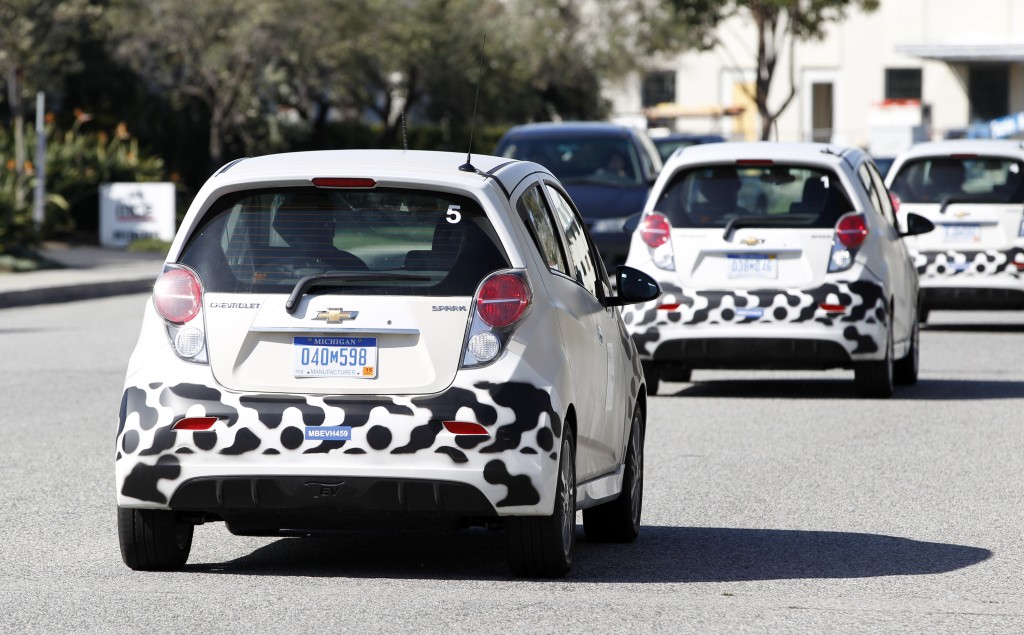
Chevrolet Spark EV Development Testing in Southern California, March 2012
The first of this year's two compliance cars, the 2013 Chevy Spark EV is an electric adaptation of its Spark minicar.
It's also GM's first battery-electric vehicle since the late lamented EV1.
Announced more than a year ago, the Spark EV will be considerably peppier than its gasoline counterpart--which our reviewer called "a dog" when fitted with the four-speed automatic option--but produced only in small numbers.
The Spark EV will use a lithium-ion battery pack with cells supplied by A123 Systems, the battery supplier that was recently bailed out by Chinese investors.
The car's electric motor--which it will build in Maryland--powers the front wheels and puts out peak power of 85 kilowatts (114 horsepower) and sustained power of about 55 kW (75 hp).
The gasoline model, by comparison, produces 84 hp from its 1.2-liter four-cylinder gasoline engine, and a whole lot less torque.
Earlier this year, Chevy did a great deal of publicity around the fact that it was testing Spark EVs in California.
Skeptical press coverage seems to have ended that, and the next step will be for the car itself to be unveiled in mid-November.
It remains unclear whether Chevy will market the Spark EV to Millennial buyers as relentlessly as it apparently will the gasoline model.
2013 Fiat 500E
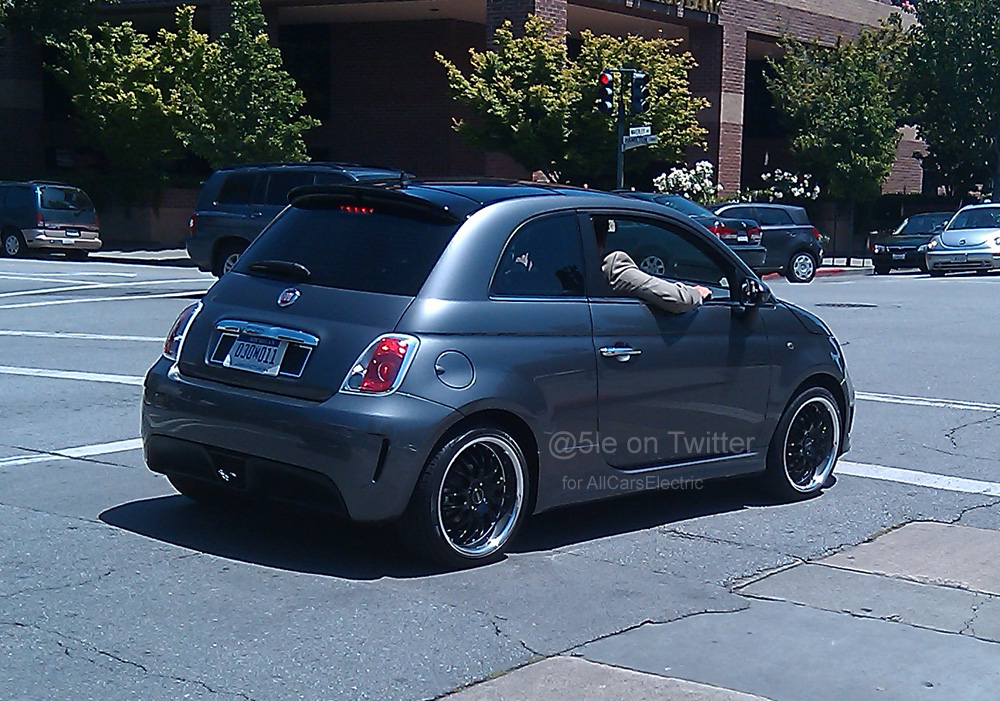
2012 Fiat 500 Electric/Elettra
So far, there aren't even photos of the finished electric version of the Fiat 500 minicar.
Prototypes have been photographed in testing for a couple of years now, but it's hardly a priority vehicle for the Chrysler Corporation and its Fiat overlords, who are preoccupied with launching a competitive range of gasoline compact and mid-size cars--never mind the plug-ins.
What will likely be named the Fiat 500E is being developed in the U.S. by Chrysler's Detroit-based engineering teams.
That's because the company has to sell a few hundred zero-emission vehicles each year to comply with California law and avoid expensive fines of $5,000 for every ZEV that it doesn't sell of its allotted requirement.
The 500E is not a car that Chrysler wants to build, and the company will lose money on every one, as CEO Sergio Marchionne has pointed out several times.
It will likely be sold only in California, but driving enthusiasts everywhere are likely hoping that Fiat manages to hang onto some of the character and the brio of the bad-boy Fiat 500 Abarth hot hatch model.
The 2013 Fiat 500E will likely be shown at the Detroit Auto Show next January, or perhaps unveiled at the Los Angeles Auto Show in early December.
+++++++++++













